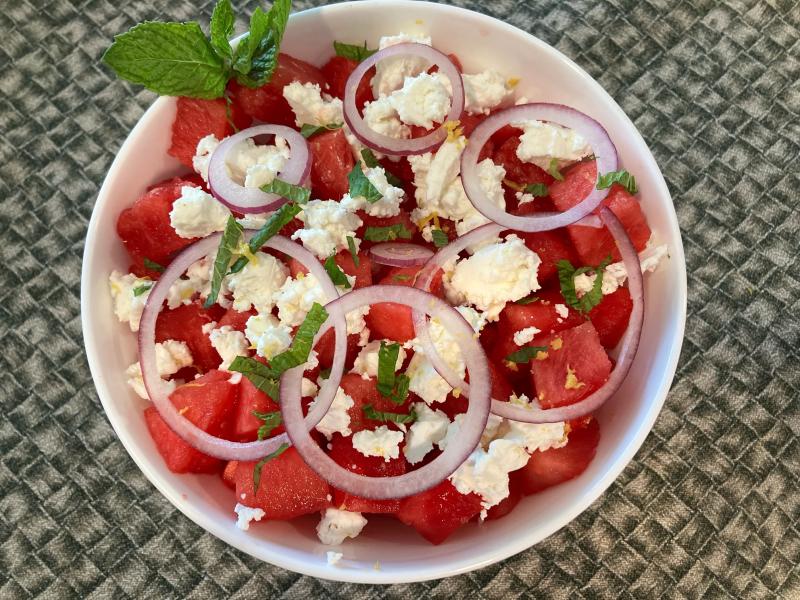Who needs a calendar – watermelons mean summertime!
Although Delaware’s watermelon season typically runs from July through September, regional grocers have already stocked their produce aisles with these ruby-fleshed fruits. Those we’re finding before the local crops are ready have likely been imported from Mexico or Central America, which you can discover by reading the little labels stuck on the rind.
Many markets offer melons cut in half and wrapped in plastic or pre-chopped pieces in containers. Since you won’t know how long ago they were packaged, I would always advise finding a whole melon to cut into yourself. If you’re not interested in trying to consume an entire large watermelon, look for the smaller, “personal-sized” ones, which are often seedless.
While most of us associate watermelon with summer picnics and backyard barbecues, we may not realize the fruit is a relative newcomer to North America. Egyptians were cultivating watermelon more than 5,000 years ago, according to archeologists who found seeds and leaves in tombs, and images of the fruit on ancient limestone reliefs.
As you may expect, watermelon has been cultivated around the Mediterranean and was considered a well-established cooling fruit in Northern Africa and the Near East. Food historians believe watermelon reached India during the ninth century and moved on to China about 100 years later. During the reign of Russian leader Ivan the Terrible, a cookbook featured instructions on pickling watermelon rinds.
Medieval manuscripts in Europe contained illustrations of watermelon, and by the 16th century, botanists were cross-breeding varieties to bring forward cultivars with sweeter, juicier flesh. The earliest records of watermelon in this country were in 1629 in Massachusetts, then 20 years later in Virginia and Florida. By the end of that century, watermelon was growing in the Mississippi River Valley and California.
Of course, Thomas Jefferson bragged that the watermelons he grew at Monticello were superior to those found in Paris, because his gardens enjoyed more sunlight. In Concord, Henry David Thoreau grew watermelons and founded an annual tradition of hosting melon parties, but there’s no record of whether or not he included seed-spitting contests.
Through careful research and DNA analysis completed a few years ago, plant scientists confirmed the Kordofan melon from Sudan was the likeliest ancestor of today’s sweet watermelon. The high water content made this a desirable and almost essential food for such an arid climate; watermelons served as “botanical canteens,” according to the practice of relying on the small, round fruits for water during dry spells.
There are countless ways to enjoy watermelon, and with more than 1,200 varieties found worldwide, there are melons in plenty of sizes, colors and degrees of sweetness. I’ve included recipes for a simple smoothie, a sophisticated soup and the salad in the photo. I used goat cheese in the salad, but you can substitute feta if you want more contrast between salty and sweet. Looking forward to local watermelons!
Watermelon Kiwi Smoothie
2 C seedless watermelon chunks
2 peeled, chopped kiwi
2 C strawberry yogurt
1 C ice
mint sprig for garnish
Combine all ingredients except mint in the bowl of a blender or food processor. Purée until smooth. Pour into two tall glasses and garnish with mint sprigs.
Watermelon Soup*
1 6-lb watermelon
1 C heavy cream
Pinch of sugar, if desired
1 bunch fresh cilantro
1/3 C tequila
Cut the watermelon in half and scoop out the pulp; discard the rind. Place the flesh in the bowl of a food processor and purée. Place a fine mesh sieve over a bowl and strain the purée to remove any seeds. Whisk in the cream and taste; add a bit of sugar, if desired. Tie the bunch of cilantro together with kitchen twine and submerge it in the bowl of soup. Use a wooden spoon to gently bruise the cilantro leaves against the sides of the bowl to release their flavor. Leave the cilantro in the bowl and refrigerate the soup for several hours or overnight. Just before serving, remove the cilantro, and whisk in the tequila to combine well. Serve in small bowls. Yield: 6-8 servings. *Adapted from “Patrick O’Connell’s Refined American Cuisine: The Inn at Little Washington.”
Watermelon Salad
4 C cubed seedless watermelon
2 T olive oil
1 T rice wine vinegar
1 T lemon juice
2 T minced mint leaves
4 oz crumbled goat cheese
1/4 C thinly sliced red onion
salt and pepper, to taste
In a serving bowl, whisk together oil, vinegar and lemon juice. Gently toss the watermelon cubes with vinaigrette. Scatter mint, goat cheese and onion on top; toss to combine. Season to taste with salt and pepper. Yield: 4 to 6 servings.



















































